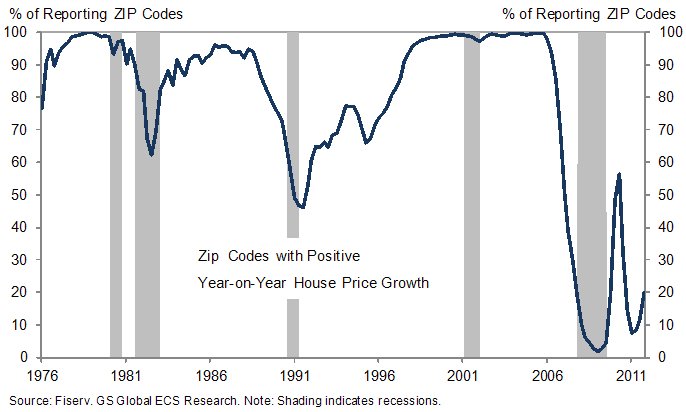Some of the hottest technology stocks in 2012 weren’t really even technology stocks.
3D printing, an industrial technology that has actually been around for nearly 30 years, suddenly seems to have come of age. Technology refinements, lower prices and an emerging consumer market drove 3D printing stocks higher in 2012, with Stratasys (SSYS) up 164% for the year, 3D Systems (DDD) rising 270%, Arcam (AMAVF) up 145% and Proto-Labs (PRLB) up 36% from its February 24 IPO.
And 3D printing has gotten off to a strong 2013. In the first week of January, at the annual CES convention in Las Vegas, private company MakerBot wowed crowds with a (relatively) low-cost dual extruding 3D printer, which can print in two differing materials and in two different colors. Wowee.
From a stock market perspective, it’s not hard to see why these companies’ shares recently took off. Revenues for this group grew around 20-30% in 2012. Street analysts predict no slowdown any time soon. And with war horses like Microsoft, Nokia and Research in Motion fading fast, there are fewer and fewer options for growth investors.
There’s no doubt that 3D printing (also known as stereolithography to old-timers like me) offers tangible benefits to manufacturers, shortening product development times and reducing waste. But there are two dangers on the horizon for investors: 1) the assumption that a consumer-oriented mass market will develop for these machines, and 2) the destructive cannibalization of these companies’ profitable high end devices.
First, the consumer market. My belief? It’ll never happen. The current “low-end” of commercial 3D printers costs about $10,000 a unit, plus a few thousand dollars per year in plastic resin. Newer devices, like 3D Systems’ Cube and CubeX printers are priced as low as $1400. Could $1000 be far off? $500?
But getting consumers to buy millions of these devices isn’t about the price of the box. It’s about the time and effort necessary to make anything useful. As for effort, consider that industrial design is done by professionals with years of education and practical experience. Capable designers make high five-figure salaries. Because of the high labor expense of industrial design, there has already been sufficient motivation to create easy-to-use CAD-CAM software.
And yet none exists. Catia, AutoCAD, Creo and other CAD programs are powerful, but as yet they have not become easy to use, even for professionals. So the idea that the existence of cheap 3D printing will somehow beget easy-to-use design software is delusional.
Some have compared the arrival of cheap 3D printers with that of cheap word-processing software and ink-jet printers 30 years ago. But that was different, because typing was a skill already possessed by the majority of educated adults, and people were already comfortable with the process of creating documents. The PC/WordPerfect combo simply facilitated something that was already happening on a large scale. But the ability to use even rudimentary 3D design software is not a common skill, nor is it one picked up easily. There’s a reason why computer-aided design is a white collar profession, while the ability to type used to qualify a person for… the typing pool.
As for the time involved, consider that the revolution in manufacturing is occurring because rather than send a design to a metal foundry and receiving a solid prototype back three weeks later, you can now get a plastic version in three hours. That’s an immense improvement in productivity. But will a consumer wait three hours for their home 3D printer to kick out a replacement chess piece? A coffee stirrer? Or some other tchotchke? Except for a few thousand early adopters, I doubt it.
Meanwhile, back on the factory floor, how long will commercial customers of industrial-grade 3D printers react to seeing these ultra-cheap consumer machines when they’re paying $50,000 – $100,000 for the “big iron”? In our new world of BYOD (“bring your own device”), you’d better believe that manufacturing operations managers will be test-driving all the new low-end devices and pressuring their traditional suppliers for a good explanation why they’re paying so much.
It’s not hard to see 3D Systems and Stratasys as the Wang Labs and Digital Equipment in this updated drama: high-tech behemoths about to be overrun by Moore’s Law, as newer equipment selling for 1 or 2 orders of magnitude less collapse their business models.
What would make my dire predictions not so dire? The availability of inexpensive printing media other than plastics like ABS and PLA. Aircraft-grade steel would be nice. Ceramics and glass would be good too. With materials like these, you could actually manufacture real products, rather than just prototypes. And of course it would be nice to make things in minutes or seconds, rather than hours.
But until then, watch out. The publicly-traded 3D printing firms (both the device manufacturers and the service bureaus) are trading at lofty premiums, based in part on what low-end devices will do to expand the market.
In the near term, the investment outlook is rosy due to simple momentum. But as with an object created by a 3D printer, sometimes you can’t see the flaw in the plan until a lot of time has gone by.
Photo: makerbot
—



